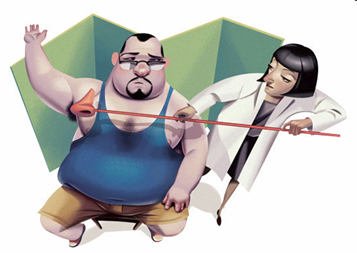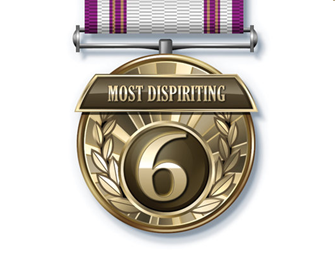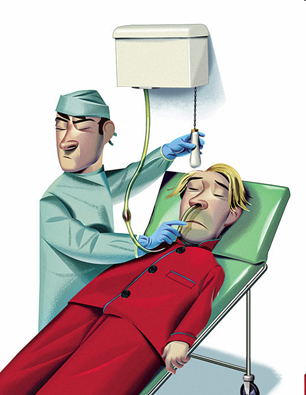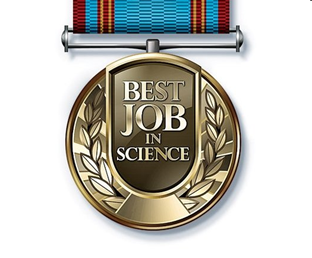#10 - Bad Dance Observer

It’s no chore to watch supermodels shake it in a nightclub. But Peter J. Lovatt, a former professional dancer and a psychologist at the University of Hertfordshire in England, must examine the often unflattering gyrations of everyone from preteens to the elderly in search of the influences and motivations behind human dancing. Lovatt and his team record videos of the dancers and then quantify their groove thang using a special movement-analysis technique and software. Other times, observers rate traits such as the overall attractiveness of the dancers’ movements on video, or the observers wear a visor that tracks what elements of the dancer they are looking at. Findings suggest that young women rate the dancing of middle-aged men as less attractive than the dance moves of younger men, perhaps an evolutionary trait that discourages women from choosing older mates—middle-aged men tend to use big, uncoordinated movements, and women typically find complex movement most attractive. But don’t lose hope. Above age 60, men dance with more complexity. They also exhibit their highest dance confidence at that age. No wonder grandpa thinks he works it so good.
#9 - Oceanic-Snot Diver
Every so often, the Mediterranean hocks up a loogie. The balls of mucus, known as “marine mucilage,” are enormous, gelatinous masses of organic material emitted by stressed-out plankton. They harbor everything from dead shrimp to bacteria known to infect humans. Fishermen have encountered the mare sporco (“dirty sea”) off Italy’s eastern coast for centuries. But the snotballs now appear more frequently, last several months, and sometimes reach over 120 miles in length. Antonio Pusceddu of the Polytechnic University of Marche in Italy and other scientists don scuba gear and jump right in with the foul globs, using large syringes to collect jugs of the material to study in the lab. Pusceddu’s findings indicate that global warming could be putting slime production into overdrive; other scientists worry that overfishing and pollution in the region may contribute to the mucus by disrupting the local ecosystem. Whatever’s causing it, it’s nasty. “The smell of mucilage can vary depending on the age of these aggregates. At the very beginning, these smell like seafood,” Pusceddu says, “but with time, the smell shifts to the one typically associated with decomposing eggs.”
#8 - Dung Curator
In the 1970s, Jim Mead started collecting dung from Ice Age critters and modern beasts during his paleological research. By the time he signed on with Northern Arizona University in 1985, he was already hoarding a lot of poo. Now at East Tennessee State University, Mead hosts what’s believed to be the largest collection of excrement in the world, around 13,000 specimens pinched off by extinct ground sloths, porcupines, you name it. The dung, collected from digs, zoos and various hikes around the world, is dried out and stored in archival-quality cardboard boxes. When scientists need to identify a piece of dung, they will often send it to Mead for identification. But the collection is more than just a dookie archive; researchers from around the world can pull DNA fragments from the material, use plant matter stuck in the poo to re-create ancient diets (“Look! Corn!”), gather indicators of past climate conditions, and use biochemical markers to determine the gender and health of the animals that left them behind.
#7 - Sneeze Modeler
Someone sick sneezes near you, and then you get ill. Obvious, right? But the work done by University of California at Berkeley researcher Mark Nicas and others modeling infection pathways shows that we barely understand how infection works. The size of the particles coughed onto you matters, as does where they land. That’s why Nicas, under a joint grant from the Department of Homeland Security and the Environmental Protection Agency, has begun a hunt for better data on bursts of mucus and saliva. A volunteer swishes a salt solution before coughing on a plastic face. Using a chloride-ion detector, Nicas and his assistants can determine how much spittle hits the vulnerable parts of the face. “For 100 years, no one has tried in a good way to measure what fraction of cough fluid would strike the eyes, nose and lips,” he explains. “Information like this currently doesn’t exist.”
#6 - Armpit Detective

Your fingerprints, retina and even your voice are now forms of ID. But you have an identifier no one’s using yet: your smell. Groups at the Monell Chemical Senses Center in Philadelphia and at Florida International University hope to isolate the compounds that give us each a unique aroma. The problem is that our diet, medications, toiletries and other factors make it difficult to discern natural scent from manufactured odorants. And so, since 1973, George Preti of Monell has collected human odors, recently focusing on the underarm, the mouth and urine. For example, using solvents or a technique called solid-phase micro-extraction, Preti pulls odorants from an underarm pad fitted to a subject. The samples go to the lab for storage in a freezer that is legendary for its overpowering musk. Despite fits and starts of government interest and funding (Darpa has bankrolled research since 2008 as part of its chemical-detecting RealNose project), the elements of an odor print have been elusive. But collecting the smells has led to other discoveries. Preti is using his work, for instance, to develop ways of sniffing out certain cancers, like melanomas and ovarian carcinoma, which release volatile, detectable biomarkers.
#5 - Tissue Reaper
Lungs, hearts and kidneys are the diamonds of the transplant world, but the rest of the human body can be recycled for later use as well. After a donor’s death, a team of tissue technologists shows up at the hospital. Out come the bags and scalpels. Skin on the back of the legs goes to skin grafts. Technicians remove arm and leg bones and later grind them into a paste to patch holes in bones during other surgeries. Even a damaged heart can be stripped of useful valves. For a full tissue recovery, the team is on the job for as long as 10 hours at a time, triple-bagging the bits and putting them on ice. The tissue is then taken to a processing center, where the materials are given a thorough cleaning and techs slice off excess pieces of muscle or bone before they cryopreserve them, which keeps the remains usable in living patients for up to five years. “You definitely have to be quirky to do this job,” admits one technician from the Pacific Northwest who preferred to remain unnamed. “But one organ or tissue donor can enhance up to 50 lives. That’s what I focus on.”
#4 - Doomsday Factchecker

Imagine an inbox full of questions from sleepless, apocalypse-obsessed teenagers. That’s what Mayan archaeologists and other meso-American researchers are up against since the release of the movie 2012 and the accompanying boom in end-of-the-world media. Three years ago, a distraught message from a teen to Anthony Aveni, an astronomer at Colgate University who specializes in meso-American culture, led him to write The End of Time: The Maya Mystery of 2012, a book that investigates and discredits the 2012 scenarios. Nonetheless, he and his colleagues still get 2012 questions at cocktail parties. “The apocalypse comes from a pop-culture way of thinking based on Christian philosophy,” Aveni says. “Some of my colleagues are getting irritated by it and brush it off, but I see it as a special teaching moment.” He hopes the hoopla might pique interest in the Maya. And the world-ending myths? “If the American public believes in crazy theories,” he says, “we’re not doing our jobs.”
#3 - Whale Slasher
Michelle Berman, an associate curator of vertebrate zoology at the Santa Barbara Museum of Natural History in California, is wary of whale organs in general, but blue-whale kidneys top the list. “They fill the entire bucket of an excavator and weigh hundreds of pounds,” she explains. “You have to make sure it doesn’t fall on you when you cut it free.” When a whale or dolphin washes ashore nearby, Berman and her colleagues study the remains. Smaller animals can be taken back to the lab, but whales—like a huge blue whale that washed up dead in 2007—have to be processed on-site. The crew, wearing yellow rain slickers and using long-handled knives, cuts the blubber off in yards-long strips before diving into the thoracic cavity. Berman then systematically cuts through the innards organ by organ, collecting samples before the organs are lifted carefully out of the way—sometimes using heavy machinery—to reveal the next layer. Besides researchers wading knee-deep in blood, the whale’s fatty oils stick to skin and hair, and the smell can last for years. “[A fresh corpse] has a metallic smell to it, because the myoglobin has lots of iron in it,” Berman says. “As the whale decomposes, it gets that rotting smell.” Gases in a decomposing whale can build up and launch guts all over the beach if you make a wrong cut. (Luckily, Berman has only had a dolphin explode on her.) Her samples have helped determine that a killer whale had died of salmonella and that parasites were causing mass beachings of pilot whales. The more she cuts, the more she learns. “If I’m stinking up the place, that’s how you know I’m working,” she says. “Once we get enough samples, it benefits the species as a whole.”
#2 - Bean Counter
After 10,000 years of intensive agriculture, we still don’t understand key things, like the best moment to plant soybeans. So Andrew Robinson, at the time a master’s candidate in agriculture, and his research assistants took on a very boring task. They planted 72 plots of soybeans at different times near Indiana’s Purdue University campus. Robinson and his crew then harvested 10 plants from each plot for study and counted each plant’s reproductive and nonreproductive nodes and seedpods and beans per pod. From there, they weighed the beans 300 at a time. After 72 plots, “when you’re just counting plant after plant after plant,” Robinson says, “your head goes spinning.” To keep his assistants from nodding off, Robinson let them periodically do protein or oil analysis (“Really? Can I?”) before putting them back to hand-counting beans. Results showed that planting beans in April or early May can lead to higher yields, and the work earned Robinson his master’s degree. Now, as he pursues a Ph.D. at Purdue, he’ll spend the next few years hand-counting beans from about 750 plots—more than 10 times the size of his first experiment.
#1 - Feces Piper
The rise of superbugs means that antibiotics, humanity’s weapon against microbes, are no longer getting the job done. Clostridium difficile, for instance, infects as many as half a million Americans a year, causing diarrhea, blood poisoning and kidney failure, and leads to 5,000 to 20,000 deaths annually. A potential cure? Introducing healthy poo into an infected patient’s gut to help recolonize the body with good, microbe-fighting bugs. The procedure, called a fecal transplant, typically involves collecting and processing stool from a healthy relative and feeding it through a nasal tube into the patient’s small intestine. The procedure, performed at just a handful of hospitals in the U.S., is controversial. Only observational evidence—no controlled studies—suggests that the procedure is effective, and doctors worry that shared poo could transmit hard-to-detect nasties. But the big challenge is the stigma of the procedure: It takes a strong stomach to offer a patient the chance to have poo up his nose.
Best Job:
Multispecies Baby Tickler
We know that apes are ticklish. But does ape and human laughter mean the same thing? Marina Davila-Ross, a neuroscientist at the University of Portsmouth in England, sought an answer in what is perhaps science’s most enjoyable research project: tickling human and ape babies to compare their laughter. After tickling the babies of several colleagues and recording their giggles, Davila-Ross traveled the world, recording the laughter of baby chimps, bonobos, gorillas and even a siamang, a gibbon found in Southeast Asia. In most cases, she held the mic as the apes’ handlers tickled the little ones. (“Apes are like us—many won’t be tickled by a stranger,” she explains.) But after three months in an orangutan rehab center in Borneo, she got to do her own tickling on half a dozen furry orange babies. Her research suggests that tickle-induced laughter developed in a common ancestor 10 to 16 million years ago. “It was fun,” Davila-Ross admits. “It’s play behavior, and everybody—apes and humans—enjoys that.”









0 comments: on "The 10 Worst Jobs in Science"
Post a Comment